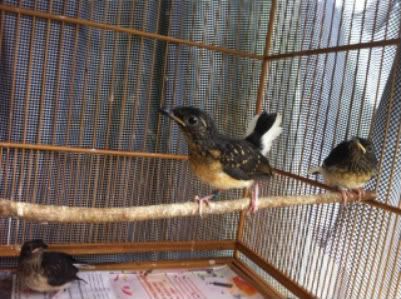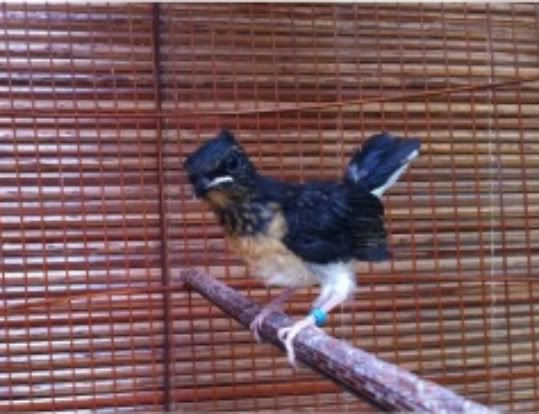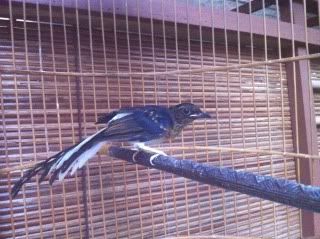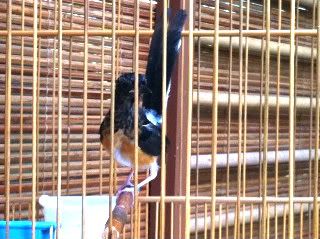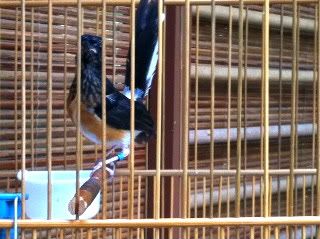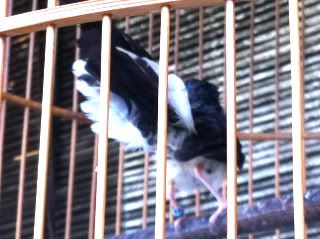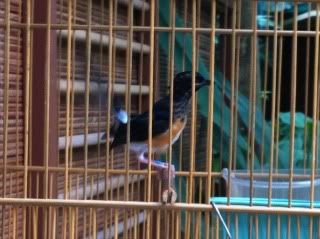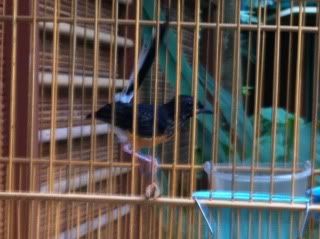↧
Article 24
↧
Article 23
↧
↧
Miscellaneous
Photos taken over the weekend
![Photobucket]()
![Photobucket]()
Internet Fraud
Buyers of shamas should beware of purchasing based on what they see on the internet. Make a Google search of "jual murai lomba" (selling competition shama). Click on the video at the top of the page and you will see a recording of a shama that is being offered for sale by someone in Indonesia. The seller claims that the bird is a Medan shama that is super ready for competition.
Actually, the video is my recording of Skyhawk that was copied from the internet. Needless to say, the person offering the shama for sale is in no position to sell the bird and any money that is sent will result in disappointment.
My new shama
Yesterday, I bought the male shama below. I was with Alan in the morning when he mentioned that the bird was available for sale. I always like to view shamas that are for sale and I went with Allen to see it.
It was undergoing the molt from juvenile to adult plumage. Its body had completed the change but the tails had a long way to grow still as they were only about 4".
I estimated the age of the bird at 6 to 7 months. I liked its character and structure but unless the primary tails exceed at least 9" when fully grown, I would not want to use it as breeding stock. I decided to take a chance and acquired it.
![Photobucket]()
![Photobucket]()
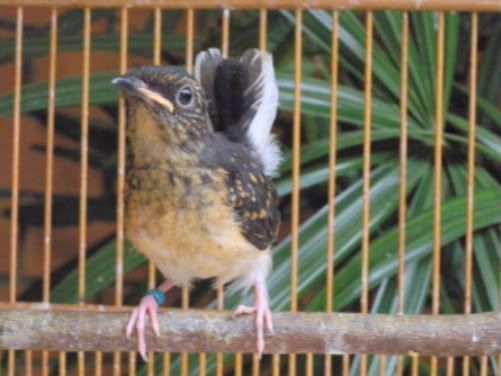
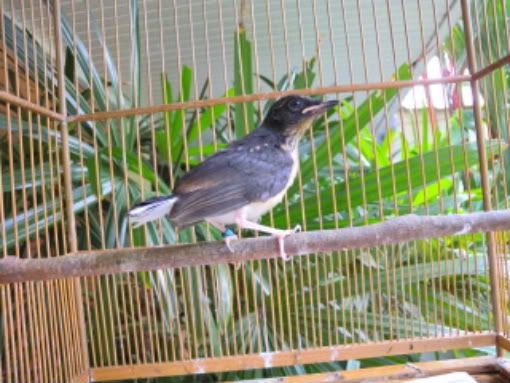
Internet Fraud
Buyers of shamas should beware of purchasing based on what they see on the internet. Make a Google search of "jual murai lomba" (selling competition shama). Click on the video at the top of the page and you will see a recording of a shama that is being offered for sale by someone in Indonesia. The seller claims that the bird is a Medan shama that is super ready for competition.
Actually, the video is my recording of Skyhawk that was copied from the internet. Needless to say, the person offering the shama for sale is in no position to sell the bird and any money that is sent will result in disappointment.
My new shama
Yesterday, I bought the male shama below. I was with Alan in the morning when he mentioned that the bird was available for sale. I always like to view shamas that are for sale and I went with Allen to see it.
It was undergoing the molt from juvenile to adult plumage. Its body had completed the change but the tails had a long way to grow still as they were only about 4".
I estimated the age of the bird at 6 to 7 months. I liked its character and structure but unless the primary tails exceed at least 9" when fully grown, I would not want to use it as breeding stock. I decided to take a chance and acquired it.

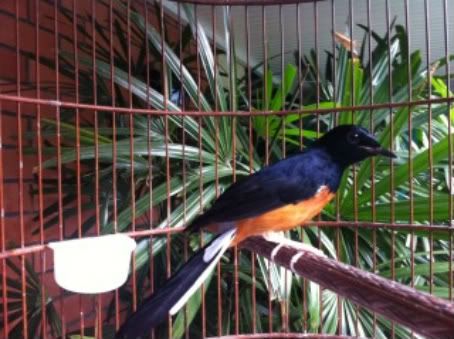
↧
Proposed Shama Club
Dr. Mike Sun is an avid shama hobbyist and in an email to me yesterday, he floated the idea of forming a shama club in Singapore. For those who do not know him, Mike founded the very successful Discus Club (Singapore) in 1997 and was its president until he stepped down 2 years ago for "leadership renewal".
The shama club that he has in mind will be basically a hobbyists' club .... non-commercial, and non-profit orientated. It will probably model on the Discus Club(Singapore).
I think it is a fantastic idea to have an active shama club and I have informed Mike that I would want to be an active ordinary member.
Those who are interested in participating in the proposed club or to provide ideas for it, may contact Mike at seeseng_sun@yahoo.com.sg
The shama club that he has in mind will be basically a hobbyists' club .... non-commercial, and non-profit orientated. It will probably model on the Discus Club(Singapore).
I think it is a fantastic idea to have an active shama club and I have informed Mike that I would want to be an active ordinary member.
Those who are interested in participating in the proposed club or to provide ideas for it, may contact Mike at seeseng_sun@yahoo.com.sg
↧
Article 20
↧
↧
Zee
In my post of 12 May 2011, I mentioned that I had acquired a wild-caught shama through the kindness of my friend William and the owner.
When I first saw the shama (“Zee”), he seemed a desirable acquisition, There was no hint that he was likely to be spectacular but I was glad to have him anyway. He had neat curved tails of about 10”, good posture and he sang a little. It is so difficult nowadays to find a wild-caught shama with at least 10” tails. In considering Zee’s performance, I took into consideration that he was about to molt and not performing at his best.
When I first saw the shama (“Zee”), he seemed a desirable acquisition, There was no hint that he was likely to be spectacular but I was glad to have him anyway. He had neat curved tails of about 10”, good posture and he sang a little. It is so difficult nowadays to find a wild-caught shama with at least 10” tails. In considering Zee’s performance, I took into consideration that he was about to molt and not performing at his best.
When I returned home, I placed him in a cages instead of directly into an outdoor aviary. This was to make sure that he was eating well. After several days, I transferred him to an outdoor aviary to molt. During the time he was in a cage, he did not exhibit signs of potential greatness.
He had a good molt. By this, I mean that his old feathers were replaced with glossy new feathers and his form rose and continued to rise as his molt approached its end.
When he was in good form after the molt, I introduced a female into his aviary. They took to each other and she built a nest. I am sure she laid but there were no eggs when I inspected the nest sometime after she should have sat but did not. One of the pair or both must have destroyed or eaten the eggs. This was not surprising as the breeding birds are constantly disturbed by the songs of the other birds in my garden.
I decided to transfer the pair to the only indoor aviary that I have. They liked this aviary but the disadvantage to me was that I had to keep all my other shamas away from them. This meant that I could not even have a shama in the nearby porch as Zee would get very excited and it was not possible for me to always ensure that Zee was not disturbed.
Again, the pair had eggs and again there was none when I inspected the nest. On the morning of Saturday, 18th June, I decided not to breed Zee for the time being and the pair were separated. Zee was transferred to a cage and it was covered to let him rest. Part of the reason for not continuing to use the indoor aviary for breeding was that I missed the free use of it to provide exercise for the 1 or 2 caged birds that I keep indoors..
In the evening of the 18th itself, Jeffrey, Alan and I were to meet Dr. Sun at his home. It was just a gathering to while away the time talking about birds and such. I wanted to bring along a shama to encourage Dr. Sun’s birds to perform. I had a choice between Zee and Apache as there was space for only 1 bird in the car. I took Zee though I did not expect much from him. This was the first time I was taking him for an outing. He had been in an aviary and I had never seen him perform in a cage. Furthermore, birds that are separated from their mates seldom do very well at gatherings.
Zee had not been taken for car rides and there was a likelihood that he might be upset by the journey and flutter about the cage but he was quiet in the car. As we walked towards Dr. Sun’s home from our parked car, we could hear his many shamas singing. At his home, I removed the cage cover and hung the cage. We were all surprised by how Zee did.
A bird that seldom travels is likely to be stressed by the journey in a vehicle. The stress can be seen from the open beak which will usually close after the ride when the bird has had time to calm down and had 1 or 2 sips of water. Birds that are stressed do not perform well. Moreover, shamas are territorial and when entering unfamiliar territory they tend to be intimidated by the resident shamas. Also, as I have mentioned, Zee was a breeder.
Zee exhibited no signs of stress from the journey. Neither did the other shamas cow him. Immediately the cage cover was removed, he straightened and opened his beak as wide as a main gate (I exaggerate a little) and belted out his songs in a variety of long musical notes.
The wide-open beak during song indicates aggressiveness and fearlessness. Very few shamas have such a strong character that they will open wide their beaks in song when challenged outside their territory. Usually, the song and display is a fraction of what it is at home. The effect of an aggressive shama in full song tends to intimidate the shamas around him. This is a great advantage in a song competition.
The wide-open beak during song indicates aggressiveness and fearlessness. Very few shamas have such a strong character that they will open wide their beaks in song when challenged outside their territory. Usually, the song and display is a fraction of what it is at home. The effect of an aggressive shama in full song tends to intimidate the shamas around him. This is a great advantage in a song competition.
I was happy with Zee’s song and character but these alone did not make him a “complete” shama. There needs to be a captivating display. Here again, Zee did not disappoint. He would “run” along the perch with an upright and dominating posture and also “play” the cage all the time singing. Some birds display and some birds sing. Zee did both. When landing on the perch, he would lift his tails and fan them out in almost slow motion. Fanning of the tails is always an attractive feature. It is usually done rapidly but it is even more eye-catching when done in slow motion.
My sifu, Jeffrey, commented that Zee is the best shama he has seen this year. I suppose this is a compliment but I know that Jeff has seen more motorcycles than shamas recently.
My sifu, Jeffrey, commented that Zee is the best shama he has seen this year. I suppose this is a compliment but I know that Jeff has seen more motorcycles than shamas recently.
We were at Dr. Sun’s home for about 1½ hours and Zee performed during this time. I was proud of him and decided to give him a name. I named him "Zee". He was formerly referred to only as “the bird that I got from William’s friend”.
↧
Flame
↧
Breeding
Sat, May 14, 2011
Subject: Re: Questions from Penang Shama Lover
Hi David
I studied and learnt from your blog and web since 2006, I would like to thank you as this is the most resourceful web regarding shama
In the past, I have kept 3 females but not success in breeding program.
In 2009, a friend gave me one hand-fed female. I paired her with one wild catch male 7’ tail, below are the results
· 1st nest in 2009 June, 4 eggs, one fertile, 3 unfertile, none of them hatched
· 2nd nest in 2010 Jan, built nest, but did not lay egg
· 3rd nest in 2010 Apr, built nest, but did not lay egg. In June, to simulate her, I ask one quail egg from pet shop, I put the quail egg in her nest, she sit and it hatched, my daughter is keeping the white color quail now
Introduced the same female with wild catch male 8.5”tail
· 4th nest in 2010 Oct 2nd, built nest 2nd day, laid one egg in Nov, unfertile
· 5th nest in 2011 Feb, built nest, seen the male courting, sit for 6 days, stop. The pair still in the outdoor aviary, stay peacefully, till to date, the nest still in the nest box. I have given them multi vitamin 3-4 times a week, daily with worms, crickets, 2-3 grass hopper, they did not like guppy
May I know should I separate them or let them continue in the aviary?
Is there anything else I can do?
Thanks in advance
NWK
Reply: Monday, May 16, 2011 8:58 AM
Subject: Re: Questions from Penang Shama Lover
Subject: Re: Questions from Penang Shama Lover
If the pair build their nest and there is then no eggs, it is likely that they may have destroyed and/or consumed the eggs. The cause is stress caused by disturbance. You need to see if this is so and take corrective action.
Infertile eggs is probably due to the male not being sufficiently fertile. I feed my breeding birds a multi-vitamin 3 times a week, B-complex 4 times a week and an oil vitamin of A, D3 and E three times a week.
If there is a shortage of aviaries, I do not separate the pair after the breeding season. Otherwise, I prefer to separate them.
Best regards,
David
Thu, Jun 23, 2011
Hi DavidUpdates:I have visited several pharmacies unfortunately they don’t sell B complex in liquid formOn 27th May, bought one liquid B complex, however, the hen start sitting on 26th May, no chance to give her before she laid eggI continue giving the pairs multi vitamins, B-complex every alternate day, no vitamin on every MondayEgg did not hatch after 12 – 13 days, she stop sitting in day 23 (17 June). I have taken out the nest and found one egg. The egg was not in the middle of the nest, it was at the corner of the wooden nest.I broke the egg, there was something inside, brown color, I believe chick died during sitting periodI have decided to change nest material. My worry is broom material too soft, egg might be pushed out from nest to the corner of the wooden box cause chick died during sitting period.On 22nd June, I put nest material in aviary, the hen starts build nest. Nest was built around 15% due to she had selected soft nest material (broom), she had rejected the harder material (minor nest material).23rd June, I found one egg on the ground near the nest material; I have moved the egg into the nest. I have put lot of soft nest material (broom), hope she continues to build the nest and start sitting tomorrow.Regards
Reply
| Fri, Jun 24, 2011 | |
I think any of the liquid B vitamins will do. I prefer Twinlab because it is viscous and sticks more easily to the insects.
I occasionally have problems with the eggs being laid in a small depression in the nest cavity or not in the main cavity itself. This is more the fault of the female in the way she builds the nest than the nesting material.
An egg on the ground suggests that one of the parents removed it from the nest and is not a good sign. The pair should be disturbed as little as possible.
Best regards,
David
↧
Weekend iphone photos of 2 months old captive-bred juveniles
Constant attention to improving the character, structure and song of my captive-bred shamas has led to what is likely to be the most promising crop of youngsters this year than I have bred over the years. My friends who have seen my birds and the results of my breeding program over the years also share this view.
Breeding brings with it the excitement and hope each year of producing that one in a million shama.
Weekends and spare time during the breeding season are enjoyably spent placing the taimong cages together and assessing the birds as I and my friends try to see if there is a special bird and if we can spot it.

However, nothing is certain with juveniles and what appears ordinary one day may turn out to be the special one on another occasion, perhaps after the molt. That's why I and other serious breeders are so reluctant to part with our juveniles.
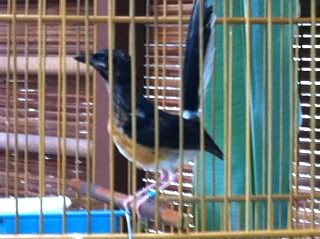


The accompanying photos are the result of assessing some juveniles over the weekend. They added interest to the morning as we passed our time with each person having his personal favourite and exchanging comments over which of the birds is "better" than the others.
The birds look a little scruffy as the body molt has commenced but it may be a month or more before they shed their tails.
For me, I like the juvenile in the 1st, 2nd, 4th, 5th and last photo. As can be seen, he is showy and I took more pictures of him than of his 2 brothers as he tended to pose more readily than them. He shows attitude and if I eventually decide to keep him, I may name him, "Boss".
This is not to say that his 2 brothers are not as "good" as him. It is just that at the weekend, he looked the most promising to me but it may be different next week or in months when his brothers or others may outshine him.
In fact, on Saturday evening, I took along his brother when Jeffrey, Alan and I visited Dr. Sun's home where he had an informal gathering of some shama friends.
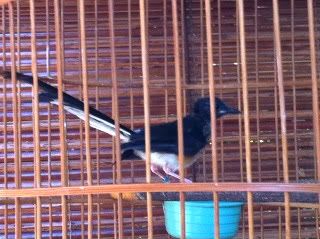
His brother looked really good at Dr. Sun's home and received many favourable comments (6th, 9th and 10th photo). The third juvenile is in photos 3rd, 7th and 8th. I was not able to fully catch his display and the best I could do is what you see in photo no. 8. However, as commented by Jeffrey, "he lifts his tails until they hit his head".
I had caught the birds with a net from their aviary only the day before and they had not had time to settle. I expect there will be more enjoyable weekends when we reconsider our choices and wait impatiently for the juveniles to complete their molt.

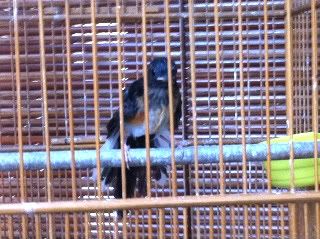

↧
↧
Article 15
↧
Zee
↧
Shama Prices
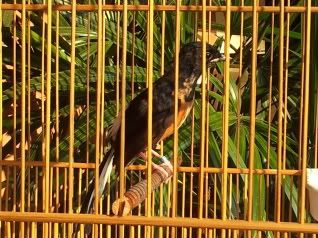
I receive many requests to buy my shamas and it may be of help if I set out the letter that I write in response to a general inquiry.
Hi
Thank you for your interest in my shamas.
I keep shamas as a hobby and may breed only a few pairs each year.
My aim is to produce birds of outstanding quality - with excellent structure, strong character, musical song, and primary tails that are at least 12”. Such birds are rare and are much sought after. They are hardly ever found any more in the wild.
It has taken many years to develop my present strain of shamas. I would discourage beginners from keeping such birds. They are more difficult to keep in perfect condition because of their long tails and they cost many times more than the shamas available from the shops.
My excess males usually go to friends and I hardly have birds for sale - perhaps 3 to 6 juveniles a year. Last year, I had no juveniles available for sale.
The price of a male juvenile, if available, is from S$3,500.00 to more than S$4,500.00. To put things in perspective, I recently paid S$7,000.00 for a captive-bred first molt male shama with tails of 11.5", and this was supposed to be a special price to me from a fellow breeder.
Because of the scarcity of the type of birds that I try to breed, there is always a waiting list of buyers for my juveniles. If you are still interested and prepared to wait, please let me know your budget and I will get back to you if I have a shama that may meet your requirement.
I keep shamas as a hobby and may breed only a few pairs each year.
My aim is to produce birds of outstanding quality - with excellent structure, strong character, musical song, and primary tails that are at least 12”. Such birds are rare and are much sought after. They are hardly ever found any more in the wild.
It has taken many years to develop my present strain of shamas. I would discourage beginners from keeping such birds. They are more difficult to keep in perfect condition because of their long tails and they cost many times more than the shamas available from the shops.
My excess males usually go to friends and I hardly have birds for sale - perhaps 3 to 6 juveniles a year. Last year, I had no juveniles available for sale.
The price of a male juvenile, if available, is from S$3,500.00 to more than S$4,500.00. To put things in perspective, I recently paid S$7,000.00 for a captive-bred first molt male shama with tails of 11.5", and this was supposed to be a special price to me from a fellow breeder.
Because of the scarcity of the type of birds that I try to breed, there is always a waiting list of buyers for my juveniles. If you are still interested and prepared to wait, please let me know your budget and I will get back to you if I have a shama that may meet your requirement.
Best regards,
David
↧
Letter from Greece
2011/9/4 Manos Venianakis <venianakism@yahoo.gr>
Dear Mr. De Souza,My name is Manos Venianakis and I'm writing from Greece.I'm an avian culturist currently breeding common canaries,saffron finches and a variety of australianfinches.I recently acquired a pair of shamas.The birds I believe are of the copsychus malabaricus indicus subspecies.could you please verify this?I was in search of a pair for some time but finding them in Greece was impossible.In the end I had to import the birdsfrom Germany and a breeder that was willing to sell a pair after the end of the last breeding season.They're about two years old.
My pair are the only shamas in Greece..I hope that this will soon change and other enthusiasts will follow.
While waiting for the birds the past few months, I had the time to do some research and was lucky enough to come across
your blog which has become my "bible" regarding shamas.Trully an excellent job there,so please accept my sincere congratulations.It has been a week now that I have the birds.The male has been into molt since then,which I believe is due to the change of their
environment and the difference in temperature.In Germany,the temps were around 18 celcious,while here in Greece and the isle of
Crete in particular,are currently around 30+ celcious.The birds are kept outdoors.Strangely, the female does not show any signs of molt.The former owner kept the pair together all year round and insisted that I did the same in order to avoid future problems in breeding season.He advised to place a box in the flight for them to sleep in when weather gets colder,the way he kept them in Germany.He also suggested a nest
and nesting material should be placed.I did that but unfortunatelly, although they're a true pair that have raised chicks,the male twice attacked the female the first couple of days and had to
seperate them.I left the female by herself in the flight to dominate the space and placed the male close to her in a large cage.By doing this I also had the chance to approach the male in order to make him accept food from hand.The previous owner had never done that but I knew
it was possible with shamas.At the beginning he was wild,attacking the cage bars, wings wide open.Slowly and gently I had him taking the mealworms
from pinches, after 5 days of trials.He got the message and to my surprise,the bird only yesterday came and sat on my hand which was a delightful treat for me...
The female still is very reluctant but always excited in the presence of live food.I offer my shamas a variety of live food every morning and afternoon.Mealworms,crickets,grasshoppers,waxworms and guppies.The only live food they were
offered by the previous owner, were mealworms and crickets.They accepted the fish as if they'd always been in their diet,which was very pleasing.Please note that I breed my own mealworms ,waxworms and guppies.I have also started a programme of breeding my own acquatic frogs,african clawed ones in particular.
The other insects are collected from nature and safe areas not sprayed with insecticides.They've even tried cicadas!The dry food I offer them is a mixture that I prepare and consists of the following..Nutribird pellets,Unikomplet and C19.Orlux insect patee.Orlux tropic pateeClaus Green TYPE 2They are also offered chopped apple and grapes which they seem to like very much.Again note that no fresh fruit had ever been offered to them in Germany!
B complex and multivitamins along with calcium is on their diet as well.
I send you videos with the birds.I'd appreciate any comments and advice that you may have.Especially on how to handle the agression that occured and how to get the pair together again.
Please feel free to "correct" me if you think I do something wrong.I always seek the best for my birds and shamas are a "new territory" for me..I'd also like to know your opinion regarding the quality
of my pair.
I love my birds and in order to honour you for the valuable knowledge you offer to all us shama enthusiasts, I have named my birds with malayan names..Malik for my boy and Noor for my girl...
Thank you very much for your time,I look forward to hearing from you.
Best regards,
Manos
show details Sep 5 (2 days ago) |
Hi Manos,
I found your email most interesting. I hope you don't mind me giving my views in point form.
1. A pair that has been separated for even a short while will treat each other like strangers.
2. Birds that are strangers to each other should only be released into the same aviary when they are both in breeding condition. Otherwise, the male will attack the female.
3. A female in breeding condition will sing and display to the male in an adjoining cage. If she squats and quivers her wings she is over-ready. This means that if she is placed in the same aviary as the male and she rapidly builds a nest, at least the first few eggs will be infertile.
4. A male in breeding condition will display and sing softly to the female which is nearby. A male that visits a nest-box in the aviary is in breeding condition. A male that is not in breeding condition will not visit the nest-box.
5. The male will come into full breeding condition about 1 1/2 months after it completes the molt. The female, about 1 month.
6. A sudden change in temperature may cause a "false" molt. That's why birds that are usually kept indoors should not be transferred outdoors.
7. Changes in temperature affect birds differently. Some molt and some don't. I suppose that's why the female did not molt.
8. The food that you offer looks fine. Shamas that have live food readily available may not willingly eat dry food. For this reason, I feed my non-breeding birds dry food until early evening before offering live food.
9. The most important vitamin for shamas is B complex. In addition, I also feed a mult-vitamin.
Best regards,
David
↧
↧
Article 11
I am happy to inform that the Shama Club (Singapore) has been registered in Singapore.
The purpose of the Club is to:
You can write to shamaclub@hotmail.com for any enquiries."
The purpose of the Club is to:
• To promote the keeping and breeding of White-rumped Shama (Copsychus malabaricus) as a hobby
• To promote the research and study of White-rumped Shama (Copsychus malabaricus) in all aspects.
• To organise exhibitions of White-rumped Shama (Copsychus malabaricus) and all equipment and materials related to shama.
• To foster friendship among local and international hobbyists and breeders.
An interim committee has been set up. The members are:
President: Dr Sun See Seng
Vice President: Derrick Goh
Secretary: R. Govindarajan
Asst Secretary: Ronald Thia
Treasurer: Kelvin Tan
Asst Treasurer: Augustine Wong
Other committee Members:
Dr Hsu Li Chieh
Eddy Cheong
Steven Lim
Paul Koh
Philip Lim
Tan Boon Hoh
• To promote the research and study of White-rumped Shama (Copsychus malabaricus) in all aspects.
• To organise exhibitions of White-rumped Shama (Copsychus malabaricus) and all equipment and materials related to shama.
• To foster friendship among local and international hobbyists and breeders.
An interim committee has been set up. The members are:
President: Dr Sun See Seng
Vice President: Derrick Goh
Secretary: R. Govindarajan
Asst Secretary: Ronald Thia
Treasurer: Kelvin Tan
Asst Treasurer: Augustine Wong
Other committee Members:
Dr Hsu Li Chieh
Eddy Cheong
Steven Lim
Paul Koh
Philip Lim
Tan Boon Hoh
The Club is now open for membership registration. Membership fee is S$50 per year. The Club invites all who are interested in the Shama to help by volunteering their services and knowledge.
You can write to shamaclub@hotmail.com for any enquiries."
↧
National Bird Singing Competition
The National Bird Singing Competition was held at Potong Pasir, Singapore, yesterday. I entered Michael's shama, Piston, for the competition. I have been keeping the bird as Michael's interest in shamas is presently very low as he has reverted to his primary interest which is Oriental White-eyes and Red Whiskered Bulbuls.
Piston was the only shama that I had available for the competition as my other birds are molting as we approach the tail end of the breeding season in the tropics. Piston placed 2nd in the competition. He is what Michael and I refer to as a "competition bird". By this we mean that he is easy to keep and to bring into form. We expect that he will continue to improve as we better understand what is required to prepare him for competition.
Piston was the only shama that I had available for the competition as my other birds are molting as we approach the tail end of the breeding season in the tropics. Piston placed 2nd in the competition. He is what Michael and I refer to as a "competition bird". By this we mean that he is easy to keep and to bring into form. We expect that he will continue to improve as we better understand what is required to prepare him for competition.
↧
Vitamin B Complex (3)
Tue, Sep 20, 2011 at 11:47 AM
Hi DavidI think there is some problems with my shama. I noticed that the feather under the body is turning to white colour instead of brown.
It also became very still and spend most of the day on the ground of the cage. Can you please advise me
Thank youRegardsAllan
Hi Allan,
The feathers turning white is probably due a deficiency in minerals. My experience has been that as a shama gets old, some of its feathers (usually the black tails) are unable, during molt, to absorb certain of the minerals that are required for pigmentation. The result is the white colour. The condition seems to be permanent as I have never seen feathers that have turned white revert to their original colour. Apart from the change in colour, the bird is fine.
The cause of the bird being still and spending most of the day on the floor of the cage probably has nothing to do with the lack of minerals that cause the white feathers. The most likely cause is a deficiency of Vitamin B Complex. This vitamin is needed for the digestion of protein and also for the nerves to function properly. A deficiency of this vitamin will result in the bird eating less. Where the deficiency is great, the bird will get fits from which it may not survive. Please check my blog on this topic.
Best regards,
David
↧
Competition Held On 7th November 2011
Unusually, there were 2 shama song competitions held on the same day in Singapore
Michael and I entered our captive bred shamas in both contests. Apache was entered in Bedok where there were more than 50 entries and Piston was entered in AMK where there were more than 40 entries.
Piston was second in the AMK competition.
The contest at Bedok was won by a young shama bred by Alan Pang. Apache only managed a consolation prize. Jimmy's magnificent long-tailed shama was fifth. It was bred by Ronald from Road Runner, a male bred by me.
The contest at Bedok was won by a young shama bred by Alan Pang. Apache only managed a consolation prize. Jimmy's magnificent long-tailed shama was fifth. It was bred by Ronald from Road Runner, a male bred by me.
↧
↧
The Bare-throated Whistler
A songbird that has recently interested me greatly is the Bare-throated Whistler. It is endemic to the area in Indonesia known as Nusa Tenggara, or Lesser Sunda Straits. This area comprises many small islands north of Australia, between the islands of New Guinea and Bali. One of these islands is Flores on which the BTW thrives but the Lesser Sunda Straits also include the islands of Komodo, Rinca and Padar that are part of the Komodo National Park where the Komodo Dragon lives. By-the-way, the name "Flores" is from the Portuguese Copa de Flores, or Island of Flowers.
The habitat of the BTW is relatively small, occupying a total area of about 20,000 sq km spread over many islands. The species is classified by CITES as Least Concern. Recently, though, some BTWs have begun to appear in the "pasar burung" or bird markets and if their popularity increases (which is likely as hobbyists get to know their marvellous song), they could become endangered in time.
The habitat of the BTW is relatively small, occupying a total area of about 20,000 sq km spread over many islands. The species is classified by CITES as Least Concern. Recently, though, some BTWs have begun to appear in the "pasar burung" or bird markets and if their popularity increases (which is likely as hobbyists get to know their marvellous song), they could become endangered in time.
The Lesser Sunda Straits have a dry tropical climate with the higher slopes of the islands having deciduous forests with tall conifers. The BTW inhabits these forested hilly areas up to 5,000 ft. I came across several Indonesian texts that mention that the birds occupying the area below 1,400 ft are not as good songsters as those above 1,400 ft. Apparently, the repertoire of the birds that live higher up the mountains may be 40% more than those living below 1,400 ft.
Consider this. At sea level, the climate of the Lesser Sunda Straits is tropical. Then, for every 1,000 ft above sea level, there is an approximate drop in temperature of 2.1 degrees centigrade. At 1,400 ft, the difference in temperature from sea level is about 3 degrees C. At 5,000 ft, we are in the temperate zone.
The climatic temperature of the hilly region where the BTW is found, therefore varies from tropical to temperate. Apparently, the birds in the temperate zone sing better than those in the tropical. I have provided below, a YouTube video of a singing BTW. It is an exceptional songster. Judging from the condensed breath emanating from its beak, which suggests cold, and the tropical plants near it, I would think that this particular bird's habitat is above 1,400 ft. There are many differences in the singing ability of the BTWs in the YouTube videos and their habitat may be a main factor causing the difference.
Consider this. At sea level, the climate of the Lesser Sunda Straits is tropical. Then, for every 1,000 ft above sea level, there is an approximate drop in temperature of 2.1 degrees centigrade. At 1,400 ft, the difference in temperature from sea level is about 3 degrees C. At 5,000 ft, we are in the temperate zone.
The climatic temperature of the hilly region where the BTW is found, therefore varies from tropical to temperate. Apparently, the birds in the temperate zone sing better than those in the tropical. I have provided below, a YouTube video of a singing BTW. It is an exceptional songster. Judging from the condensed breath emanating from its beak, which suggests cold, and the tropical plants near it, I would think that this particular bird's habitat is above 1,400 ft. There are many differences in the singing ability of the BTWs in the YouTube videos and their habitat may be a main factor causing the difference.
I first came across a reference to the BTW in an article that described it as the Flores Nightingale. It seemed to me that a bird whose song is comparable to that of the Nightingale, which is so highly prized in the western hemisphere, deserves further investigation. I should say that the song of the BTW is nowhere similar to that of the nightingale. It is a better mimic and has a more varied song. In fact, the songs and the birds ability to imitate, are more akin to that of the amazing Australian Lyre bird.
I researched and read all the articles that I could get my hands on in English and Indonesian on the internet and listened to many recordings of the BTW's song on YouTube and mp3, to try to learn as much as I could about the bird and its song, diet and the care that it requires. This post represents almost all the information that I was able to gather on the BTW but I cannot vouch for the accuracy and some of it may be more myth than fact.
In Indonesia, the BTW is popularly known as Burung Samyong. When enquiring about the bird in the pasar burungs, this is the name to use. In the Lesser Sunda Straits, the name by which the BTW is known is Burung Garugiwa. When making an internet, or You Tube search for the BTW, type the words "bare-throated whistler", "samyong" and "garugiwa" to obtain the most useful results.
The BTW belongs to the family of birds known as Whistlers. These include the Golden Whister which inhabits Australia and the Mangrove Whistler; birds that are known for their songs. What little I know, suggests that the BTW outshines all other whistlers in their singing ability.
I understand an older name for the Whistlers is "Thickheads". The BTW certainly has a large head and a strong beak. It is a somewhat stocky bird of about 6 ½” to 7” of which 1/3 comprises the tails. It is about the size of a Golden Oriole or 2/3rds the size of a common mynah.
I understand an older name for the Whistlers is "Thickheads". The BTW certainly has a large head and a strong beak. It is a somewhat stocky bird of about 6 ½” to 7” of which 1/3 comprises the tails. It is about the size of a Golden Oriole or 2/3rds the size of a common mynah.
The name Bare-throated Whistler at once brings to mind that the bird has no feathers in the area of the throat. However, this is deceiving. When you first see a bird that is not singing, you will not see any bare throat. The entire head and neck forming a collar at the breast are closely covered with black feathers. The lower parts of the bird are olive while the wings and upper body are a darker green while the tails are black, but a lighter shade than the head.
The red wattle, or the patch of red skin at the throat only becomes visible when the bird is in full song. It then stretches its neck while it belts out its song and this exposes the bright red skin of the neck which slightly balloons as it throbs with song.
The female BTW is a drab light green color in contrast to the male's quite bright colors set off by the wattle at his throat. The female does not have a wattle. The species is dimorphic which means that the sexes are clearly distinguished by their different colouring.
During courtship the female will answer the male's song with her own. The nest is cup-shaped and made up of twigs, bark and leaves. The incubation period is about 15 days.
In one description of the songs of the BTW, the singing of a pair was described as "anamorphic", suggesting that when the pair sing to each other during courtship, it may be difficult to place the exact source of the song. Perhaps it is this trait and the fact that the bird is often heard but seldom seen in the wild that has given rise to the belief among some, that the bird is a spirit.
The female BTW is a drab light green color in contrast to the male's quite bright colors set off by the wattle at his throat. The female does not have a wattle. The species is dimorphic which means that the sexes are clearly distinguished by their different colouring.
During courtship the female will answer the male's song with her own. The nest is cup-shaped and made up of twigs, bark and leaves. The incubation period is about 15 days.
In one description of the songs of the BTW, the singing of a pair was described as "anamorphic", suggesting that when the pair sing to each other during courtship, it may be difficult to place the exact source of the song. Perhaps it is this trait and the fact that the bird is often heard but seldom seen in the wild that has given rise to the belief among some, that the bird is a spirit.
The song of the BTW has been described as deafening at close range. It is certainly much louder than that of the shama. Unlike the song of the shama which often has stretches of melody, the song of the BTW is more a series of loud whistles that are strung together for several notes before changing to a different type of whistle.
A comment on the BTW that I found on an Indonesian blog mentions that a caged bird sings much better than a BTW in the wild. Another comment that I found was that the bird sings most between 8pm and 10 pm. I guess, the writer meant am and not pm.
A comment on the BTW that I found on an Indonesian blog mentions that a caged bird sings much better than a BTW in the wild. Another comment that I found was that the bird sings most between 8pm and 10 pm. I guess, the writer meant am and not pm.
The BTW is a good imitator and it tends to mimic the sounds that it hears and incorporate the sounds into its songs. Here is a video of a bird that has incorporated the sound of a car alarm into its song:
The song of the BTW is diverse and melodious with sounds that it has heard forming part of its songs. It is such a good mimic that it will readily learn and incorporate sounds into its songs that we may not find to be pleasant. For instance, it will quite realistically imitate the mewing of a cat. Being such a good imitator, the bird in the home will need to be kept away from unpleasant sounds.
Here is a video of a BTW that has incorporated a car alarm, cock crowing and cat mewing into its songs:
http://www.youtube.com/watch?v=M9wPWYbY8a0
Here is a video of a BTW that has incorporated a car alarm, cock crowing and cat mewing into its songs:
http://www.youtube.com/watch?v=M9wPWYbY8a0
The song of the BTW is apparently within the same pitch as the song of the white-rumped shama and the shama will readily imitate the BTW. In fact, the recorded song of the BTW will excite the shama like no other bird song. What would be interesting would be to keep the BTW and the shama within earshot of each other for an extended period to see the extent to which each will incorporate the song of the other into its repertoire and what the resulting song turns out to be.
The BTWs are insectivorous. In captivity, they should be fed a diet similar to the shama. The pelleted food that we feed our shamas should also be suitable for the BTW once they are converted to such food. My experience with the shama suggests that in captivity, their main diet should be pellets with live food at the end of the day. The reason for this suggestion is that the farm bred crickets and mealworms that form the main live food for our birds seem to lack sufficient vitamin B with the consequence that the BTW, like the shama, may suffer from vitamin B deficiency with resulting fits, if they are fed solely on this type of live food.
The BTWs are insectivorous. In captivity, they should be fed a diet similar to the shama. The pelleted food that we feed our shamas should also be suitable for the BTW once they are converted to such food. My experience with the shama suggests that in captivity, their main diet should be pellets with live food at the end of the day. The reason for this suggestion is that the farm bred crickets and mealworms that form the main live food for our birds seem to lack sufficient vitamin B with the consequence that the BTW, like the shama, may suffer from vitamin B deficiency with resulting fits, if they are fed solely on this type of live food.
↧
The Skylark (San Ma)
The skylark has a strong following in Singapore amongst a small but growing group of fanciers that appreciate its song and display. For myself, I have never appreciated the song of the average skylark.
For most skylarks, the song comprises of an unending series of twitters akin to the song of many sparrows. The best songsters, though, have a song that is modulated and varied and can be quite listenable.
What really impresses with the skylark is its display. It can be mesmerizing. In the best display, the skylark will begin by standing on the pedestal, which is a small “table” about 1½” in diameter in the center of the cage. It will then rapidly flap its wings and this causes it to rise like a helicopter above the pedestal. Whilst it is rising, it will continuously sing. Having risen what may be several feet above the pedestal (depending on the height of the cage), it will gently return to the pedestal, barely touch the top, and immediately rise again. Such a sight is rarely seen in a captive skylark and a bird that can do this on a regular basis is worth several times its weight in gold.
Notwithstanding my views on the skylark’s song, I have recently got a young skylark. It has a reasonably pleasant song. Also, it is quite tame and will readily take a mealworm from the hand.
When a skylark is tame it will likely sing whilst standing or walking on the floor of its cage. However, not all will stand on the pedestal and sing. This was a problem that I had with my skylark and I needed to give some thought as to how my skylark could be encouraged to stand on the pedestal and display. I list below, some of the methods that I have heard about, or thought about, or tried.
1. The standard height of the pedestal in a skylark cage can be 6” or more above the cage floor. This can be too high for an untrained bird. It helps if the height of the pedestal is lowered to 3” or 4”;
2. Instead of lowering the pedestal, several pedestals of differing heights may be placed in the cage;
3. An alternative would be to place several small blocks of wood of different heights in the cage. These can be easily removed after the bird is trained;
4. I have found that placing a tray with food with the top just about level with the birds’ head helps to teach the bird to climb;
5. One method that I have read about is to place the cage with the bird in the sun. As the sand on the cage floor gets hot, the bird will be encouraged to stand on the pedestal;
6. The method that I have found to be most effective is to cover a portion of the cage bars in the lower part of the cage so that the bird cannot see the outside if it stands on the floor of the cage. Newspaper or some other material can be used. The material should cover the bars to about the height of the pedestal. The skylark is by nature curious and not being able to see from the cage floor encourages the bird to look for a higher vantage point. Mine started standing on the pedestal within a day of using this method.
My skylark now regularly stands on the pedestal and sings. He seems to be coming into form as he quivers his wings while singing. The next step is to teach him to fly above the pedestal.
↧
Falcon
↧



